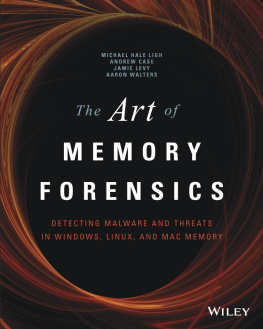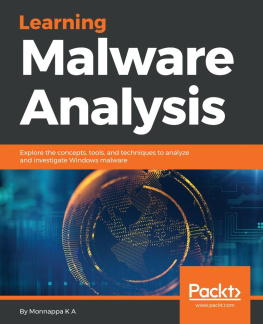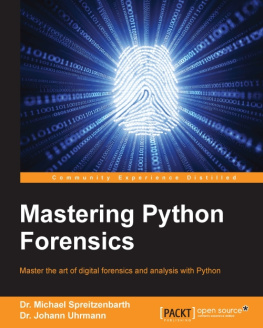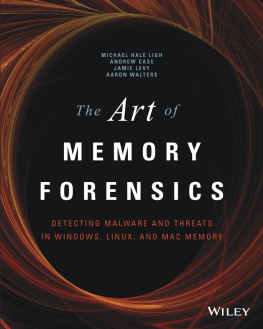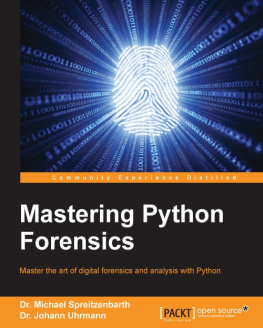Introduction
Memory forensics is arguably the most fruitful, interesting, and provocative realm of digital forensics. Each function performed by an operating system or application results in specific modifications to the computers memory (RAM), which can often persist a long time after the action, essentially preserving them. Additionally, memory forensics provides unprecedented visibility into the runtime state of the system, such as which processes were running, open network connections, and recently executed commands. You can extract these artifacts in a manner that is completely independent of the system you are investigating, reducing the chance that malware or rootkits can interfere with your results. Critical data often exists exclusively in memory, such as disk encryption keys, memory-resident injected code fragments, off-the-record chat messages, unencrypted e-mail messages, and non-cacheable Internet history records.
By learning how to capture computer memory and profile its contents, youll add an invaluable resource to your incident response, malware analysis, and digital forensics capabilities. Although inspection of hard disks and network packet captures can yield compelling evidence, it is often the contents of RAM that enables the full reconstruction of events and provides the necessary puzzle pieces for determining what happened before, during, and after an infection by malware or an intrusion by advanced threat actors. For example, clues you find in memory can help you correlate traditional forensic artifacts that may appear disparate, allowing you to make associations that would otherwise go unnoticed.
Regarding the title of this book, the authors believe that memory forensics is a form of art. It takes creativity and commitment to develop this art, but anyone can enjoy and utilize it. Like an exquisite painting, some details are immediately obvious the first time you see them, and others may take time for you to notice as you continue to explore and learn. Furthermore, just like art, there is rarely an absolute right or wrong way to perform memory forensics. Along those lines, this book is not meant to be all-encompassing or wholly authoritative. From the plethora of tools and techniques, you can choose the ones that best suit your personal goals. This book will serve as your guide to choosing what type of artist you want to become.
Overview of the Book and Technology
The worlds reliance on computing grows enormously every day. Companies protect themselves with digital defenses such as firewalls, encryption, and signature/heuristic scanning. Additionally, nations plan attacks by targeting power grids, infiltrating military data centers, and stealing trade secrets from both public and private organizations. It is no wonder that detecting, responding, and reporting on these types of intrusions, as well as other incidents involving computer systems, are critical for information security professionals.
As these attack surfaces expand and the sophistication of adversaries grows, defenders must adapt in order to survive. If evidence of compromise is never written to a hard drive, you cannot rely on disk forensics. Memory, on the other hand, has a high potential to contain malicious code from an infection, in whole or in part, even if its never written to diskbecause it must be loaded in memory to execute. The RAM of a victimized system will also contain evidence that system resources were allocated by, and in support of, the malicious code.
Likewise, if the data exfiltrated from an organization is encrypted across the network, a packet capture is not likely to help you determine which sensitive files were stolen. However, memory forensics can often recover encryption keys and passwords, or even the plain-text contents of files before they were encrypted, giving you an accelerated way to draw conclusions and understand the scope of an attack.
The most compelling reason for writing this book is that the need for memory forensics in digital investigations greatly exceeds the amount of information available on the topic. Aside from journals, short academic papers, blog posts, and Wiki entries, the most thorough documentation on the subject of consists of a few chapters in Malware Analysts Cookbook (Wiley, 2010, Chapters 15 through 18). Nearing its fourth birthday, much of the Cookbooks content is now outdated, and many new capabilities have been developed since then.
The Art of Memory Forensics, and the corresponding Volatility 2.4 Framework code, covers the most recent Windows, Linux, and Mac OS X operating systems. In particular, Windows 8.1 and Server 2012 R2, Linux kernels up to 3.14, and Mac OS X Mavericks, including the 64-bit editions. If your company or clients have a heterogeneous mix of laptops, desktops, and servers running different operating systems, youll want to read all parts of this book to learn investigative techniques specific to each platform.
Who Should Read This Book
This book is written for practitioners of technical computing disciplines such as digital forensics, malicious code analysis, network security, threat intelligence gathering, and incident response. It is also geared toward law enforcement officers and government agents who pursue powerful new ways to investigate digital crime scenes. Furthermore, we know that many students of colleges and universities are interested in studying similar topics. If you have worked, or desire to work, in any of the aforementioned fields, this book will become a major point of reference for you.
The material we present is intended to appeal to a broad spectrum of readers interested in solving modern digital crimes and fighting advanced malware using memory forensics. While not required, we assume that you have a basic familiarity with C and Python programming languages. In particular, this includes a basic understanding of data structures, functions, and control flow. This familiarity will allow you to realize the full benefit of the code exhibits, which are also presented with detailed explanations.
For those new to the field, we suggest carefully reading the introductory material in the first part, because it will provide the building blocks to help you through the rest of the book. For the experienced reader, you may want to use the first part as reference material and skip to the parts that interest you most. Regardless of the path you take, the book is intended for the digital investigator who constantly strives to build their skills and seeks new ideas for combating sophisticated and creative digital adversaries.
How This Book Is Organized
This book is broken down into four major parts. The first part introduces the fundamentals of modern computers (hardware and software) and presents the tools and methodologies you need for acquiring memory and getting started with the Volatility Framework. The next three parts dive deep into the specifics of each major operating system: Windows, Linux, and Mac. The individual chapters for each OS are organized according to the category of artifacts (i.e., networking, rootkits) or where the artifacts are found (i.e., process memory, kernel memory). The order of the chapters is not meant to imply that your investigations should occur in the same order. We suggest reading the entire book to learn all the possibilities and then determine your priorities based on the specifics of each case.
Conventions
There are a number of conventions used throughout the book, such as the following:
- Hexadecimal addresses and names of files, API functions, variables, and other terms related to code are shown in monofont. For example:

